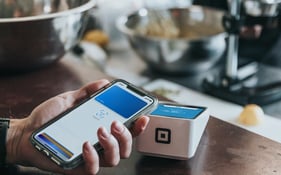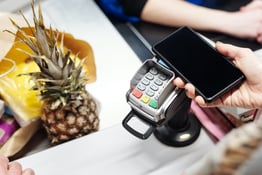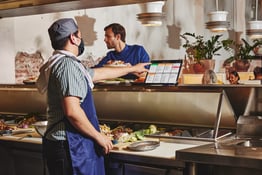When the pandemic hit, Nashville-based A. Marshall Hospitality decided to dive head first into the virtual restaurant space, nearly doubling their existing brands by opening three new virtual concepts. Each concept – NASHi Noodles, Fresh 96, and Burger Dandy – was launched out of the hospitality group’s existing kitchens, creating a low-risk opportunity.
While two of the concepts have since been brought to a close, business at one of them, Burger Dandy, grew so fast that it’s now operating as its own brick-and-mortar.
We spoke with A. Marshall Hospitality COO Lyle Richardson to talk about the group’s expansion and the main learnings from their ghost kitchen experience.
What went into the decision to open not just one, but three, virtual restaurants during the pandemic?
I’m thinking back to sitting at that table – that was fun. We started by figuring out what people wanted, and maybe needed, while thinking about what we'd like to get into in the future. We went with what we enjoyed as a group. The number one thing that came up was burgers, then ramen, and the third was something related to Cabo because our owner has a home down there where he entertains staff, so we went with something fresh and clean.
When you launched these virtual restaurant concepts, all of the food was being prepared within your existing kitchens.
Yeah, so we created our own “ghost kitchens”, trying to match up the location as well as the chefs [with each concept], while trying to also cross-utilize ingredients.
For example, we took our gastropub Americana Taphouse and said that’d be great for Burger Dandy because we already had a burger on the menu. We could modify it and go from there.
Deacon’s New South is our dry-aged prime steakhouse in downtown Nashville, and in that area at the time, there wasn’t a lot of Japanese-style cuisine. We also had a chef who was very talented in Japanese cooking, so that’s where we did the ramen.
The last one was Fresh96, the Cabo-inspired restaurant. Scout’s Pub was in a more affluent community, so we thought that community would enjoy more of the healthy, cleaner style of foods, and it also made sense with the chef there.
You ultimately shut down two of the concepts, NASHi Noodles and Fresh 96. What led up to that decision?
Honestly, we just got too busy at [the existing restaurants of] those two locations. When business started to come back, Fresh96 was doing well, but at Scout’s pub, our volume went through the roof.
We re-introduced our delivery program and added all of the platforms at all of our locations, so it changed the dynamic at our physical locations, and it was accelerating at a rate where we didn't have to have Fresh96 anymore. But we did take some of the items from the menu and added them to Scout’s Pub.
The ramen concept was doing well, too, but what happened there was a combination of getting too busy and losing our executive chef, and no one could execute those ideas like he could. By then, Deacon’s was doing $120,000 a week in sales, and the ramen concept was doing $10,000, so it negated the need as well.
Did you ever have intentions for any of the concepts to eventually become a brick and mortar?
No, it was more of, how do we get through the pandemic to support the business and our staff and also our community by giving them more options? But Burger Dandy was a different story. They started to just boom. We were comparing the sales volume and the square footage Burger Dandy was using to the Americana concept, and we found Burger Dandy was outperforming.
Guests really loved it, but they also really loved hanging out there. We had a couple bar stools at the cash register for people to use while waiting, but people would just start eating there. We were seeing these fans stick around, and with the amount of volume we were doing, it just made sense to allocate space to it.
How were you marketing the concept initially to get the word out about Burger Dandy?
We’re very big in our community, so when it was just starting as a ghost kitchen, we got them involved. We took some of the items to the fire and police departments, city offices, and local businesses. We did some TikToks and digital marketing. And we started to notice that it was picking up a lot more traction than the other locations.
Some operators have voiced that it can be challenging to market a virtual restaurant. What do you feel was most essential to your success in Burger Dandy gaining popularity?
Being on third-party platforms wasn’t going to be enough. Social media wouldn’t be enough. And we didn’t have the budget for commercials or radio spots. So we went more grassroots. The biggest thing was giving the community the product. That human-to-human connection I feel is really what made it successful.
When you get the product to the community and speak about what you're doing, they don’t care if you’re brick and mortar or a virtual kitchen. At that point in time, all they’re looking at is the actual food and if it’s something they could see themselves buying. And you can do it on a shoestring budget. There’s the labor of the people who distributed the food, the cost of the product, and some stickers to put on the foil wraps. Eventually we printed branded material, too.
Given you launched Burger Dandy out of 700-square-feet of your existing Americana Taphouse, do you think you would’ve taken the risk of bringing the concept to its own brick and mortar if you didn’t have that space?
We had the benefit of having a location – a 7,000 square foot building – where 700 feet doesn’t take up much space, so the risk was obviously much smaller. But I do feel like we would've still ventured out to find a space.
Did you change or expand the menu when you opened the physical location?
We started off very simple with three burgers, three fries, and three shakes. We wanted to test the waters, and gather feedback from our guests. We were getting a lot of requests for a chicken sandwich, and we felt if we were going to expand into a brick and mortar, we could include other options, like the chicken sandwich and a burger for the vegetarians, for example.
We already do fried chicken very well at our Puckett’s location, so we took the base of that and made some adjustments. People asked if we’d do a salad, so we added a Cobb salad, and it’s been selling very well. And we also added boozy shakes because we just thought it’d be fun.
What has customer feedback been like?
We started realizing people, especially in our market, wanted to bring their families out and not always have to order to-go. So the reception’s been great. Kids really enjoy it, too, so we’re starting to work on some programming. We’re partnering with local community schools to offer a “take your parents to dinner” gift card for A-students. We know a lot of times kids dictate where you eat. And those are the kinds of things that have helped us evolve.
What would you save have been the biggest challenges of transitioning the restaurant to a brick and mortar?
We operate existing brick and mortars, so we understood that process. Even bigger for us was just learning the ghost kitchen and delivery processes, and how to set up curbside stations and packaging for safety, and all of those elements.
Burger Dandy’s delivery and carryout is now about 40-percent of business. We’ve seen that teeter more towards dine-in as we progress. I didn’t think it’d go that far that fast. I thought we’d be sitting at 50-50 at best. But it’s good for us because as we know with delivery fees, those add up pretty fast.
What were the main takeaways you learned from the ghost kitchen experience?
It definitely made us smarter about to-go, delivery, and curbside orders, and maximizing efficiency. It helped us a lot with our training and staffing for packaging and proper transport of products. And I think we’ve become a better business for it.
It also gave us a lot of time to test out different items, and I don’t think we would’ve done that if we didn’t do these virtual concepts. But now we’ve made some adjustments at our other concepts as well – the way we package, the way we utilize third party systems. We’ve been noticing a really sharp increase in delivery and to-go orders because of it.
Packaging-wise, we became more aware. As we started testing for our ghost kitchens, we were ordering from every ghost kitchen we could find just to see how things were packaged. We learned a lot, and that enabled us to roll out a superior delivery program at our full-service restaurants.
With the third party systems, first and foremost, you have to communicate with these individuals, rather than just taking whatever they offer at face value. We had the opportunity to make phone calls and build relationships, and we were able to carry over some of that negotiating into our other restaurants and adjust the percentages.
Do you have future plans to open other virtual concepts – perhaps with intentions of making them into in-person restaurants?
Funny you bring that up because we realize this is also a good way to test future concepts, without having to go into a lease with a huge commitment. I can introduce a product to the community, gather a lot of that feedback, and then become so much more empowered to open a restaurant. You put a lot of money on the line when you open a restaurant, and most restaurants don’t make it. Personally, I recommend this route to a lot of operators that we communicate with in our area. So, yes, I'm definitely going to be testing other virtual brands in the future.
What about plans to grow Burger Dandy?
Yes – we’re trying to figure out exactly what that looks like. We’ve already had a few people interested in bringing Burger Dandy to their area, which is a great feeling. We’ll definitely have other Burger Dandy’s in the future. When and where is still up for debate, but they’ll be coming soon because this has been a really fun and good model for us to grow.
Grace Dickinson is a reporter at Back of House. Send tips or inquiries to grace@backofhouse.io.
[Photo courtesy Amy Whidby]





